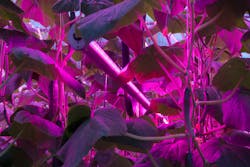Kingsville, Ontario is a place known as Canada's southernmost town. But this time of the year, “south” doesn't translate into long days of sunshine in that part of the world. So what's a cucumber grower to do? Albuna Farms came up with an answer, and this being LEDs Magazine, you probably see it coming.
Albuna is installing LED lighting tuned to optimal spectra for growing the popular salad vegetable (or fruit, to be botanically correct) across 4.7 hectares (about 506,000 ft2) of a greenhouse in the Ruthven section of Kingsville.
But rather than go with toplighting, Albuna has decided to use interlighting — the practice of suspending LED modules within the crop to focus on vital sections. The modules come from Signify.
Although some critics maintain that interlighting can be wasteful because it can end up focused on spent parts of a plant, a Signify spokesperson told LEDs that is not the case at the Albuna installation, which raises small cucumbers known as mini cucumbers.
“The fruits are always at the bottom because of the way they wire the plants,” the spokesperson said. “A cucumber crop is a high wire crop, which means that the plants will grow as long as, let’s say, 7 to 10m. This doesn’t fit the greenhouse, of course, so they lower the plants from the top, so the fruits will be at the same height always for picking.
“The grow lights are always mounted in the heart of the crop, where the daylight has the most difficulty to reach the leaves for photosynthesis. So that means that it’s about 1.5m from the bottom of the plants, usually.”
Albuna expects to complete the installation this month as a first phase of what will eventually be interlighting across the entire 7-hectare facility if all goes to plan. Signify is working with installer Honey Electric, a Chatham, Ontario contractor.
Signify declined to reveal how much Albuna is paying for the tubular Philips GreenPower modules, or how many modules Albuna is installing. Each module is rated at 92W input and an efficacy of 3.3 µmol/J.
Although many recent Signify horticultural installations have involved a mix of high-pressure sodium (HPS) and LED lighting, Albuna is tapping LED only. HPS can be desirable for lower costs and for heat, although sometimes the heat can be too much in which case LED can act as a moderator. LEDs last longer and are more energy efficient.
So what is providing the top illumination at Albuna?
“Sunlight from above,” the Signify spokesperson told LEDs.
In another nearby LED-only installation, Signify recently outfitted GoodLeaf Community Farms in Guelph with LED grow lights for baby kale, baby arugula, micro broccoli, and pea shoots. In that case, the setting is not a greenhouse, but is an enclosed vertical farm with tightly stacked growing chambers that could overheat under HPS.
GoodLeaf and Albuna are both situated in a part of Canada along a northern stretch of Lake Erie known for vegetable crops. The town of Leamington, also in the area, has the nickname of The Tomato Capital of Canada (like cucumbers, tomatoes are fruits that are commonly regarded as vegetables).
Horticultural lighting is one of the key growth drivers for Signify, as CEO Eric Rondolat reiterated earlier this month at the company's annual Capital Markets Day gathering with analysts.
MARK HALPER is a contributing editor for LEDs Magazine, and an energy, technology, and business journalist ([email protected]).
For up-to-the-minute LED and SSL updates, why not follow us on Twitter? You’ll find curated content and commentary, as well as information on industry events, webcasts, and surveys on our LinkedIn Company Page and our Facebook page.






